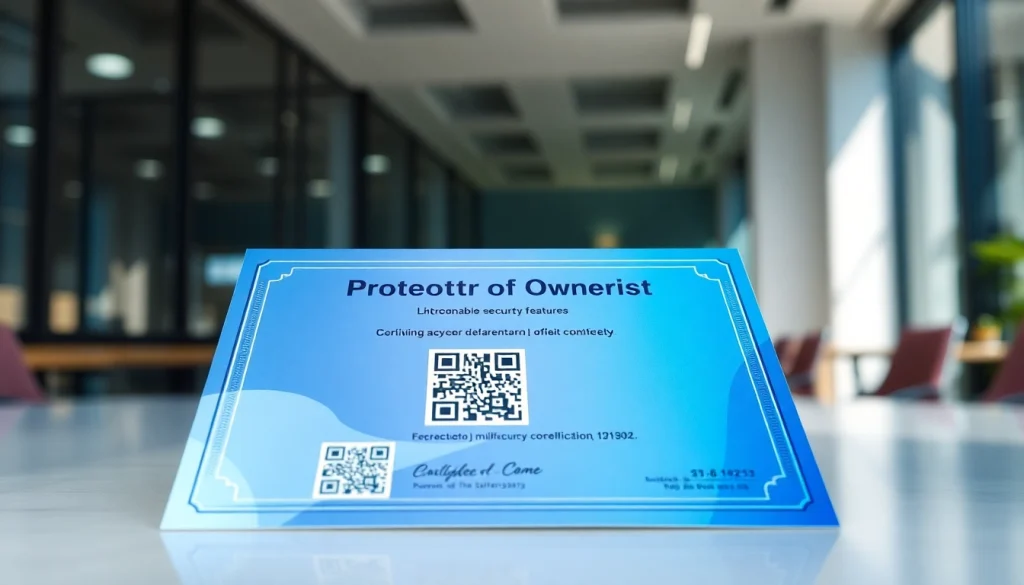
Understanding Digital Proof of Ownership
What is Digital Proof of Ownership?
Digital proof of ownership refers to a verifiable digital representation of ownership rights over a specific asset or item, whether tangible or intangible. This can include anything from digital art, music, or software to physical real estate and other valuable assets. Digital proof utilizes technologies such as blockchain, which ensures transparency and security, making ownership easily traceable and transferable.
By leveraging digital proof of ownership, individuals and organizations can protect their rights and facilitate transactions with confidence, reducing the risk of fraud and disputes.
Importance in Today’s Digital Economy
In the rapidly evolving digital economy, the significance of digital proof of ownership cannot be overstated. As businesses increasingly migrate to online platforms, the traditional methods of verifying ownership can be cumbersome and prone to errors. Digital proof streamlines this process, enhancing operational efficiency and trust among parties involved.
The rise of non-fungible tokens (NFTs) in recent years illustrates a mainstream acceptance of digital proof of ownership concepts. NFTs allow creators to authenticate their digital works, providing buyers with a sense of security regarding their investments. Beyond digital art, the applications span diverse industries, revealing a transformative impact on commerce, identity verification, and legal transactions.
Key Features and Benefits
- Security: Digital proof harnesses encryption and blockchain technology, significantly reducing the risk of fraud.
- Transparency: All transactions are publicly recorded on distributed ledgers, allowing for easy verification.
- Accessibility: Owners can easily manage their assets from anywhere, widespread internet access in mind.
- Efficiency: Automating ownership transfers reduces the time and costs associated with traditional methods.
- Traceability: Every ownership change is recorded, providing a detailed history of asset transactions.
Common Use Cases for Digital Proof of Ownership
Digital Assets and NFTs
The emergence of NFTs has revolutionized how digital assets are owned and traded. Digital art, music files, and virtual real estate can be sold or auctioned with clear proof of ownership tied to blockchain technology. Each transaction creates an immutable record, which enhances the value of digital assets and fosters creativity within the digital art community.
For artists and creators, NFTs provide not only a platform for monetization but also ongoing royalties for each subsequent sale, establishing a new revenue model that empowers creators.
Property and Real Estate Transactions
Real estate, often burdened by paperwork and bureaucratic delays, is another sector poised for disruption through digital proof of ownership. Smart contracts can automate transaction processes, from the initial offer to the final closing, while ensuring all terms are transparent and verifiable.
Moreover, blockchain can be utilized to maintain a public registry of ownership, reducing the risk of title fraud and disputes, thus simplifying the due diligence process for buyers and sellers alike.
Identity Verification
Digital proof of ownership isn’t limited to assets alone; it also plays a crucial role in identity verification. Increasingly, businesses require verified identity proof for various services ranging from online banking to job applications, where traditional documents are susceptible to forgery.
Digital identities can be verified using cryptographic methods, ensuring that users maintain control over their personal information while also establishing trust with service providers.
Implementing Digital Proof of Ownership Solutions
Choosing the Right Technology Provider
Selecting an appropriate technology provider for implementing digital proof of ownership solutions is critical. Businesses need a partner with proven expertise in blockchain technology, data security, and user experience design. Key factors to consider include:
- Experience: Review the provider’s history in implementing similar solutions across various industries.
- Technology Stack: Ensure they utilize robust and secure technologies that can scale as your business grows.
- Support: A good provider should offer ongoing support and resources for a seamless integration process.
Steps to Integration in Your Business
Integrating digital proof of ownership into your business involves several key steps:
- Assessment: Evaluate your current systems and identify areas that can benefit from digital proof capabilities.
- Stakeholder Engagement: Involve key stakeholders to understand requirements and secure buy-in.
- Proof of Concept: Start with a pilot project to test the technology and gather insights before full-scale implementation.
- Training: Provide comprehensive training for all users to promote confidence and competence in the new system.
- Feedback Loop: Establish mechanisms for user feedback to continuously improve the system.
Compliance and Regulation Considerations
Compliance with relevant laws and regulations is essential when implementing digital proof of ownership. By understanding these requirements, businesses can avoid legal pitfalls and build customer trust. Considerations include:
- Data Privacy: Ensure that the implementation complies with data protection regulations, like GDPR or CCPA.
- Ownership Rights: Confirm that digital proof mechanisms align with existing ownership laws in your jurisdiction.
- Audits: Regular audits can ensure compliance and reinforce trust with stakeholders.
Challenges and Best Practices
Addressing Security Concerns
While digital proof of ownership offers increased security, it is not without its challenges. Cybersecurity threats can target digital ownership systems, leading to potential breaches and losses. To mitigate risks, businesses should invest in robust security practices:
- Regular Security Audits: Conducting routine assessments of systems helps identify and address vulnerabilities.
- User Education: Educate users about best practices for managing digital assets securely.
- Multi-Factor Authentication: Implement multi-factor authentication (MFA) to enhance user account security.
Ensuring User Adoption and Understanding
The success of digital proof of ownership solutions relies heavily on user adoption. Organizations need to foster a culture of understanding and acceptance through clear communication and training initiatives:
- Transparent Communication: Clearly articulate the benefits and functionalities of the digital proof system to all users.
- Training Programs: Offer training sessions tailored to different user groups to ensure familiarity with the system.
- Feedback Channels: Create avenues for users to provide feedback and voice concerns to enhance system relatability.
Maintaining Transparency and Trust
Trust is paramount for user adoption of digital proof of ownership systems. Maintaining transparency throughout the implementation process can bolster user confidence:
- Open Logs: Allow users to access transaction logs to verify ownership changes and transaction history.
- Clear Policies: Develop clear policies surrounding data privacy, ownership, and transaction processes to reduce confusion.
- Community Building: Foster a sense of community among users by providing forums for discussion and sharing experiences.
Measuring the Impact of Digital Proof of Ownership
Key Performance Indicators (KPIs) to Track
To assess the effectiveness of digital proof of ownership systems, businesses should define key performance indicators (KPIs) that align with their objectives. Common KPIs include:
- Adoption Rates: Measure the percentage of users utilizing digital proof of ownership features.
- Transaction Speed: Assess the average time taken for ownership transfer processes.
- User Satisfaction: Conduct surveys to gauge user satisfaction and gather feedback on the experience.
Analyzing User Feedback
User feedback is an invaluable tool for refining digital proof of ownership systems. Regularly analyzing feedback can uncover strengths and areas for improvement:
- Surveys: Conduct frequent surveys to gather user opinions and suggestions for improvement.
- Focus Groups: Organize focus group discussions to delve deeper into user experiences and drive engagement.
- Feedback Mechanisms: Establish simple feedback mechanisms within the system for users to voice concerns or suggestions instantly.
Continuous Improvement Strategies
Digital proof of ownership systems should evolve with user needs and technological advancements. Continuous improvement strategies can include:
- Data Analytics: Regularly analyze operational data to identify trends and make data-driven decisions.
- User Training Updates: Refresh training materials and sessions to address new features or processes promptly.
- Version Updates: Plan scheduled updates to incorporate user feedback and enhance functionality based on industry trends.




